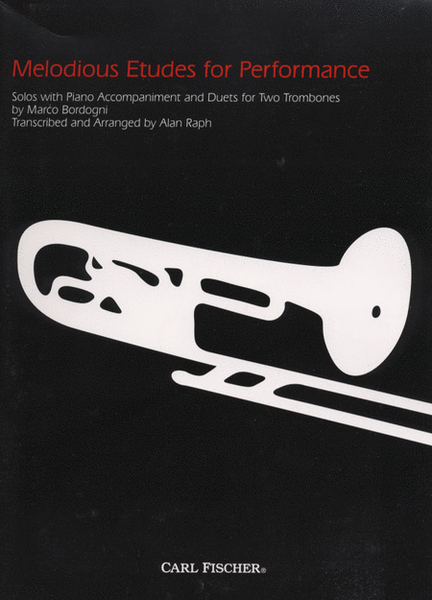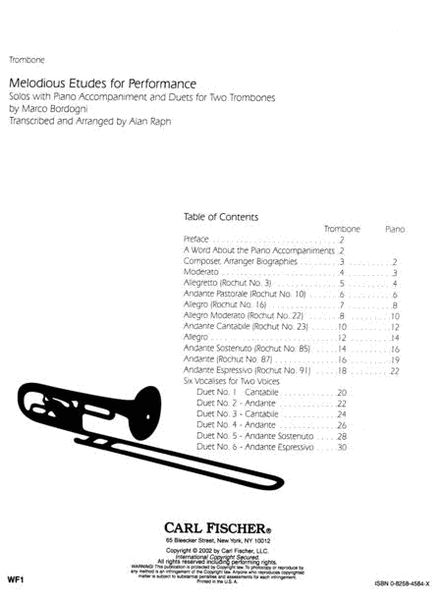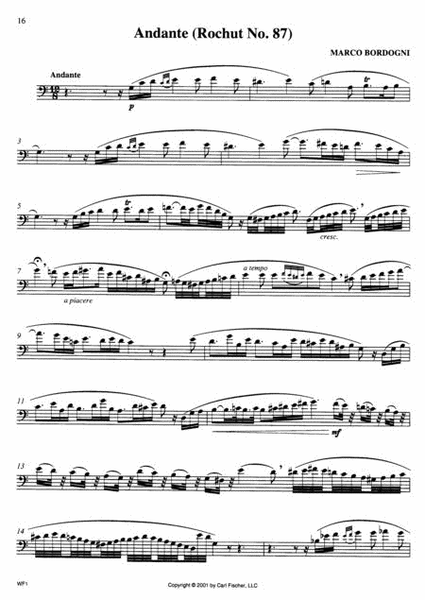Melodious Etudes For Performance
Solos with Piano Accompaniment and Duets for Two Trombones
-
Ships in 1 to 2 weeks
Details
Description
SKU: CF.WF1
Solos with Piano Accompaniment and Duets for Two Trombones. Composed by Giovanni Marco Bordogni. Arranged by Alan Raph. SWS+Insert. Collection - Score and Parts. With Standard notation. 32+24 pages. Carl Fischer Music #WF1. Published by Carl Fischer Music (CF.WF1).ISBN 9780825845840. UPC: 798408045845. 9 X 12 inches. Transcribed by Alan Raph.
Solos with piano accompaniment and duets for 2 trombones by Marco Bordogni. Transcribed and arranged by Alan Raph. 10 etudes include 8 of the favorites found in the Rochut edition as well as an additional 2 etudes. Raph chose 6 duets that work well for trombone performance.
PrefaceOne of the most gratifying aspects of studying thetrombone is to work for the “Rochut” books…MelodiousEtudes, Bks. 1, 2, and 3. These are made up of MarcoBordogni’s wonderful vocalizes, universally acclaimedas being among the most expressive and musicallysatisfying of all vocal study pieces.This book selects ten solo etudes of varying difficulty,mixing keys and styles, and presents them with theirpiano accompaniments, for concert and recital performanceby the trombonist.“Melodious Etudes for Performance” includes twoetudes not found in the Rochut books. It also includessix duets composed by Bordogni (“Vocalises for twovoices”)…every bit as expressive and lyrical as theetudes. Although some of the Melodious Etudes havealready been expanded into duets by ambitious trombonists…these are composed by the master himself.A Word About the Piano AccompanimentsWhen one studies and plays a “Melodious Etude” certainharmonies are “assumed” and the trombonistrelates accordingly. Deceptive cadences, sections inthe relative minor (or relative major), modulations…etc. all become a part of the player’s harmonic concept.When the actual piano accompaniment is thenadded, the music suddenly takes on a different character.Presumed major chords often turn out to bediminished chords, suspensions appear, sometimesmajor becomes minor…etc. The piano accompanimentadds a whole new dimension to each etude.The duets have been printed in the tenor clef and thesolo etudes are in bass clef as they are in the “Rochut”transcriptions. Notation errors have been corrected.Dynamics and expression markings have mostly beenretained from the original source. A few changes havebeen made suck as the elimination of “vocal-glissandos,”which are best played with deliberate clarity onthe trombone…and the inclusion of an occasionalclean break rather than a tie into a new section.“Melodious Etudes for Performance” will work nicely ifthey are approached as “operatic arias” withoutwords.— Alan RaphCandlewood Isle, Connecticut.



 Share
Share